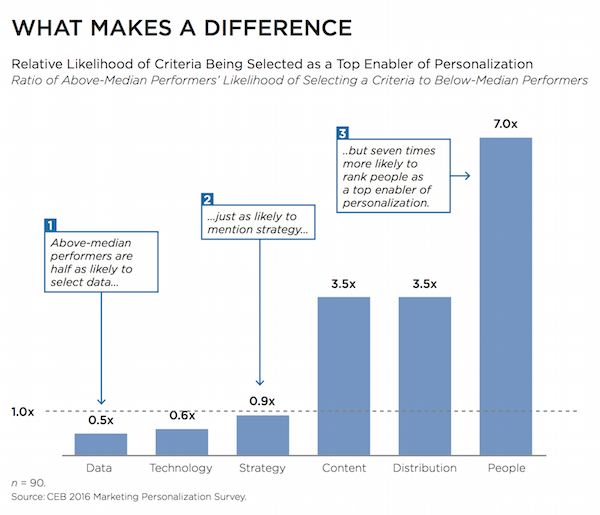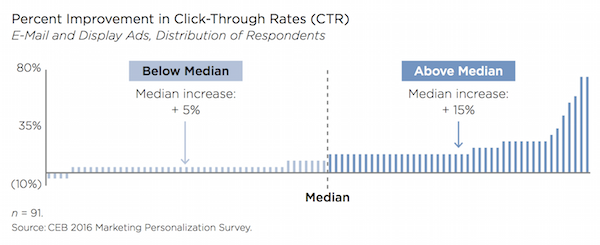
“Medicine, law, business, engineering — these are noble pursuits and necessary to sustain life,” declares Robin Williams’ character, John Keating, in the movie Dead Poet’s Society. “But poetry, beauty, romance, love — these are what we stay alive for.”
With the latest data from a study on effective personalization by the CEB, I’d riff on that:
Data, technology, strategy. These are necessary elements to make personalization function. But people — the importance placed on developing and enabling talent in your marketing organization — they are what make personalization thrive and succeed.
That may not come as a surprise, as we’ve certainly heard that advice before. Analytics guru Avinash Kaushik stated it as his 10/90 Rule back in 2006: invest 10% of your budget in tools and vendors, but 90% in your people and their training.
But skeptics among us — or in the boardroom — might be prone to demand proof.
Fair enough. CEB now has some pretty compelling evidence for you.
In researching quantitative and qualitative aspects of how around 90 major brands — companies as diverse as Burberry, Capital One, Coca-Cola, Samsung, and Target — have adopted personalization technology, CEB divided them in two groups:

- Below-median performers who were seeing little benefit from personalization.
- Above-median performers who were reaping significant benefits from personalization.

Above-median performers saw, on average, a 15% improvement in click-through rates (CTR) on personalized email and display advertising — in contrast to below-median performers who averaged only a 5% improvement.
(The lowest performers actually had personalization have a negative impact on CTR. Ouch.)
The impact on revenue indicators was similar: above-median performers achieved an impressive 16% lift as a result of personalization — 2.7X more than the below-median performers who averaged only a 6% boost.
Naturally, the question is: what do the above-median performers do differently?
If your first guess is “they spend more money” — bzzzzt, sorry, wrong answer. According to Anna Bird at the CEB, there wasn’t a big difference in investment between above-median and below-median performers. On average, it’s around a 1% difference in budget allocation.
Different marketing technologies? More marketing technologies? No, and no. On average, the marketing stacks of the aboves vs. the belows were comparable.
Okay, enough feigned suspense, as the answer is in the graphic at the top of this post: above-median performers are 7X more likely to rank people as a top enabler of personalization than below-median performers.
More interestingly, above-median performers are 0.5X less likely to select “data” and 0.6X less likely to select “technology” as their top enabler.
In contrast, the below-median performers were more enamored with data and technology and put less emphasis on people. Now, obviously, you can’t do personalization without data and technology. But the higher performing brands didn’t expect much from those raw materials on their own. Instead, they focused on developing organizational capital around technology and data.
While this research was specific to personalization, I think the pattern is broadly applicable to almost all every other marketing technology category. The magic isn’t in the technology. It’s in your people and what they do with it.
Carpe diem.
For more insights into succeeding with personalization and other marketing technologies, attend MarTech Europe in London, 1-2 November. Jason Heller, the global lead of digital marketing operations and technology at McKinsey & Company, will be one of more than 25 expert speakers at the conference, and he’ll be presenting on Personalization at Scale: What It Really Takes. “Beta” discount rate expires September 30.



